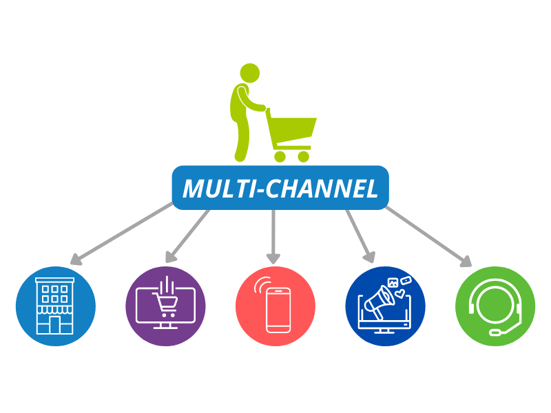If you are selling your products into multiple sales channels, don't assume that you are doing omnichannel. You probably are not, because you don't fully understand the difference between omnichannel and multi-channel.
Omnichannel is not multi-channel. "Multi" means many-- many sales channels. Omni means “all”, meaning that all your sales channels are working in harmony.
Multi-Channel Explained
In the following diagram you'll see a consumer that's interacting with a brand that has a retail store, website, mobile application, social media channels and a call center. In this example, all the processes are different, the systems are different, the product data is coming from different sources and the people managing these channels are different people. When product information is not centralized, it's because you have intentionally or unintentionally created groups of silos within your business. As a result, this can create a very frustrating customer experience, as your customer won't have a consistent experience when interacting with each of your different sales channels.
In this example, all the processes are different, the systems are different, the product data is coming from different sources and the people managing these channels are different people. When product information is not centralized, it's because you have intentionally or unintentionally created groups of silos within your business. As a result, this can create a very frustrating customer experience, as your customer won't have a consistent experience when interacting with each of your different sales channels.
For example, Fortuitas worked with a client that had an eCommerce store and an Amazon channel. One of their customers purchased a product on Amazon. After they purchased the product, the customer went on the company's website and they saw that same product, but the product description was different on the website from Amazon. The customer got upset and was concerned that they did not buy the right product. This resulted in an unnecessary call to customer service, and a potential product return by the customer.
Omnichannel Explained
The key to Omnichannel is to create an environment where the processes, systems, data, and people are all working together, as depicted in the diagram below:.png?width=484&name=omnichannel%20(2).png) In this example, the customer is going to have a much more cohesive, unified experience, whether they buy on the web, the retail store or from any other channel. This is because the company's data is centralized and the staff are all sharing this data between the different sales channels, following the same processes. They have the ability to add additional sales channels, accept different currencies, enter new markets in other countries etc, because they are setup properly to scale their business. In a true omnichannel environment, adding a new sales channel does not disrupt the business, it enhances it!
In this example, the customer is going to have a much more cohesive, unified experience, whether they buy on the web, the retail store or from any other channel. This is because the company's data is centralized and the staff are all sharing this data between the different sales channels, following the same processes. They have the ability to add additional sales channels, accept different currencies, enter new markets in other countries etc, because they are setup properly to scale their business. In a true omnichannel environment, adding a new sales channel does not disrupt the business, it enhances it!
Final Thoughts
Do you have an eCommerce website? If the answer is yes, that is great news! Do you sell on Amazon? Yes? Terrific! Do you sell through Instagram? Again, if the answer is yes then you are doing a great job. But, if all three of these channels require separate manual data entry, spreadsheets etc. just to add or update new products to each channel individually, then you are running a highly inefficient multi-channel operation that won't be able to scale. As soon as you add new products, new currencies, new languages etc. you are going to have a manual data entry nightmare if you don't already have one. Your customer experience will suffer, and so will your sales numbers.
But, if you can unlock the power of omnichannel by centralizing your product data and defining business processes that everyone must follow in your company, then you are on the right path to creating an omnichannel solution that can scale.
So, how exactly do you do that? Read some of our insights about omnichannel, and then contact us so we can discuss how you can create an omnichannel strategy for your business.



